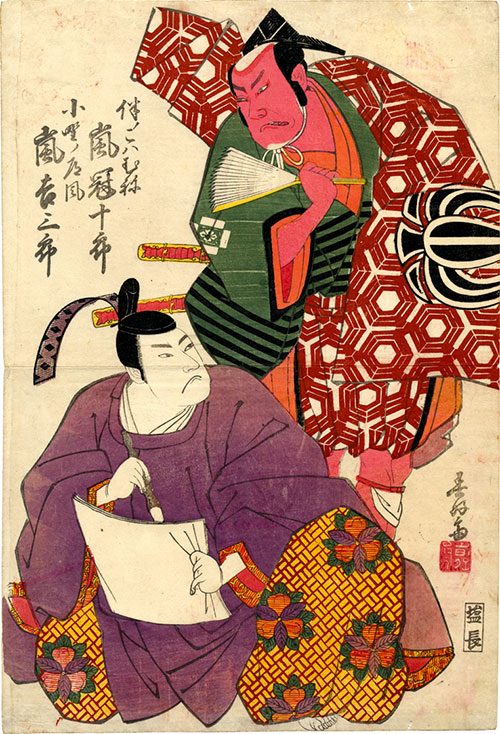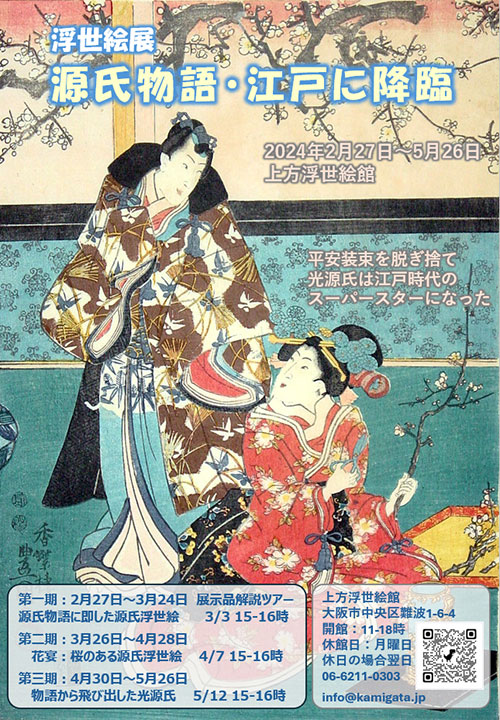Kabuki plays that feature tales of royalty
Adjunct exhibition: “The Tale of Genji appears in Edo”
February 27 (Tue) ‐May 26 (Sun), 2024
This museum exhibits ukiyo-e woodblock prints published in Osaka in the Edo period. Many of the ukiyo-e prints made in Osaka were portraits of kabuki actors, depicting how the kabuki theatres were like at the time.
Each kabuki play has particular background of era or historical event in which characters live and the story unfolds. That makes actors easier to understand and prepare for the roles they play, and easier for audience to know how the story goes.
In this feature exhibition, we focus on the Heian period when The Tale of Genji is written. Woodblock prints that depicts imperial court and society of aristocrats are being exhibited; Sugawara no Michizane in “Sugawara denju tenarai kagami”, Soga no Iruka and Abe no Seimei, who lived in the Asuka and the Heian periods are depicted.
This time we hold adjunct exhibition titled “The Tale of Genji appears in Edo” featuring “Genji ukiyo-e”. Valuable exhibits of this special exhibition are owned by a private collectors and were brought by Kyoto Art & Culture Club of Ukiyoe. I hope you enjoy the both exhibitions.

Drawn by Shunkosai
“Ono no Tofu Aoyagi suzuri”
Arashi Kanjuro I (right, playing the role of Ban no Kowamune)
Arashi Kitsusaburo II (left, playing the role of Ono no Tofu)
What is Ocho mono
Kabuki plays are roughly categorized into two genres; jidai mono (which features the time before the Edo period) and sewa mono (which features the daily lives of townspeople in the Edo period). Ocho mono, or Odai mono, is one of the jidai mono kabuki that features imperial court and the society of aristocrats before Genpei War at the end of 12 century. “Taishokukan” is a title for imperial court official in the Asuka period. Kabuki plays that features conflicts of two taishokukans, Fujiwara no Kamatari and Soga no Iruka, are called “Taishokukan”, among which “Imoseyama onna teikin” is the most famous.
Tokugawa shogunate in the Edo period banned dramatizing the samurai society, so the time is set before the Edo period when dramatizing the actual incident occurred in the Edo period such as Ako incident (The title of kabuki play is “Chushingura”). Though Chushingura and Ocho mono are set before the Edo period, their historical authenticity is not checked; their costumes and stage settings are those of the Edo period. Audience at the time seems to enjoy the actors’ performances and the kabuki world freely instead of seeking accuracy of historical incidents in the Asuka and the Heian periods.
Character Profile
※Soga no Iruka (date of birth is unknown, died in 645)
The son of Soga no Emishi. A minister under emperor Kogyoku era. He tried to make Furuhito no Oe no Oji accede to the throne who is a member of Soga clan. In order to do this, he murdered Yamashiro no Oe no Ou, Shotoku Taishi’s son. In Taika 1 (645), he was assassinated by Nakano Oe no Oji (later emperor Tenji) and Nakatomi no Kamatari.
※Ono no Tofu (894 – 966)
High ranking official in the Heian period. The grandson of Ono no Takamura and son of Ono no Yoshifuru. One of three famous Heian calligraphers along with Fujiwara no Sukemasa and Fujiwara no Yukinari.
※Sugawara no Michizane (845 – 903)
High ranking official in the Heian period. He was highly evaluated by emperor Uda and was appointed to Udaijin, a high-ranking government position. He was politically defeated by Fujiwara no Tokihira and sent to Dazaifu in Kyushu and died there in exile. People were afraid that he curse the present world so the imperial court built a shrine called Kitano Tenman-gu and dedicated it to him. He is still an object of worship as a god of scholarship as Tenma Tenjin.
※Abe no Seimei (921 – 1005)
Onmyoji (title of the official position in the Heian period). Studied astronomy and onmyodo (philosophy that is based on the Chinese principle of yin and yang) under Kamo no Tadayuki and Kamo no Yasunori (father and son). He was heavily used by emperors and aristocrats as fortune teller and ritualist. He is a legend and his episodes are written in “Konjaku monogatarishu”.

The Tale of Genji appears in Edo
“The Tale of Genji appears in Edo”
Foreword
The Tale of Genji was written almost a thousand years ago by Murasaki Shikibu. It is well-known as the world’s first romance novel. Its influence is so strong that drawings, parodies and manga related to The Tale of Genji still continue to be produced, as well as commentaries and analyses.
Genji ukiyo-e is one of these related works. It was created in the Edo period, when 260 years of peace continued. Genji ukiyo-e is woodblock prints that depict ordinary people in the Edo period while retaining the elegant atmosphere of aristocrats of the Heian period. Genji ukiyo-e is based on The Tale of Genji but is said to describe the lives of Ooku (women’s quarters of Edo Castle) and gained great popularity among townspeople, especially women and children.
At this part 1 we mainly exhibit the works of Utagawa Toyokuni III, the creator of Genji ukiyo-e. Enjoy the world of Edo-style Genji ukiyo-e which is a little bit different from traditional Heian-style ukiyo-e.
Saito Akira : President, Kyoto Art & Culture Club of Ukiyoe